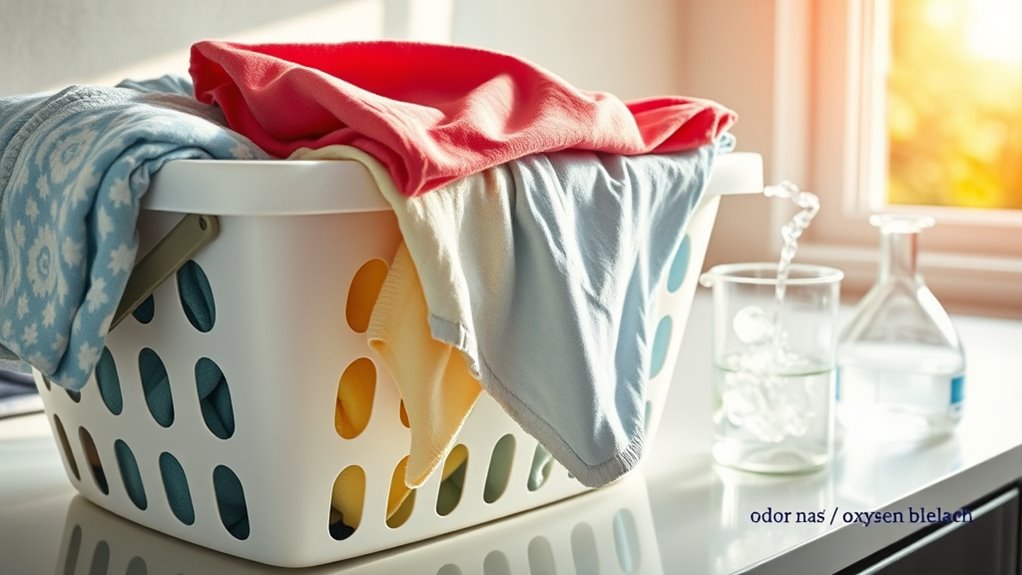When choosing between enzymes and oxygen bleach for odor removal, I consider their unique benefits. Enzymes are great for breaking down organic smells and stains, especially on delicate fabrics, and work well at lower temperatures. Oxygen bleach, on the other hand, excels at disinfecting and whitening, making it ideal for tough, musty odors. To really understand which works best for your laundry needs, keep exploring the details behind each method.
Key Takeaways
- Enzymes specifically break down organic odor-causing molecules, making them effective for protein-based stains and smells.
- Oxygen bleach releases oxygen to lift stains and odors, providing a broad-spectrum cleaning action suitable for various soils.
- Enzymes are gentle, safe for delicate fabrics, and work well at lower temperatures, while oxygen bleach requires careful use to prevent fabric damage.
- For organic odors and stains, enzymes are often more targeted and effective; oxygen bleach is better for heavy dirt and mold.
- Choosing between them depends on fabric type, odor nature, and stain severity, balancing efficiency with safety considerations.

Laundry science is all about understanding how different fabrics, stains, and cleaning agents interact to achieve the best results. When it comes to odor removal, I’ve found that choosing between enzymes and oxygen bleach depends on understanding their mechanics and safety considerations. Enzymes are biological molecules that work by breaking down organic compounds, which are often the source of stubborn smells like sweat, food, or pet odors. Their enzyme efficiency is remarkable when it comes to tackling these organic stains, especially on protein-based fabrics like wool or cotton. I appreciate how enzymes target specific molecules, making them highly effective without needing harsh chemicals. Plus, they work well at lower temperatures, which helps preserve delicate fabrics and save energy.
On the other hand, oxygen bleach is a more chemical-based approach that relies on the release of oxygen to lift stains and odors. It’s usually made from sodium percarbonate, which releases oxygen when dissolved in water. I’ve noticed that oxygen bleach is very versatile and effective on a wide variety of stains, including those caused by dirt, mold, or mildew. When using it, I always keep bleach safety in mind—it’s *essential* to follow instructions carefully because overuse or misuse can damage fabrics or cause color fading. Unlike enzymes, which are gentle and specific, oxygen bleach can be a bit more aggressive, so I prefer to use it with caution on delicate or brightly colored items.
Additionally, understanding the chemical reactions involved helps me choose the appropriate cleaning agent for each situation. In my experience, enzyme efficiency shines brightest on organic odors and stains, especially when I pre-treat laundry with enzyme-based detergents. These enzymes work quickly and don’t leave behind harmful residues, making them a safe choice for regular use. Oxygen bleach, however, is excellent for overall whitening and disinfecting, which can also help eliminate odors caused by bacteria or mold. It’s particularly useful when I’m dealing with heavily soiled or musty laundry. Still, I always pay attention to bleach safety—using the right amount and avoiding prolonged contact with delicate fabrics helps prevent damage.
Ultimately, I think the best approach depends on the specific odor and fabric. Enzymes excel at breaking down organic smells and are safe for everyday use, while oxygen bleach offers a powerful, broader-spectrum solution for tougher odors and stains. By understanding their chemistry and safety guidelines, I can choose the right method to keep my laundry fresh and clean without risking damage.
Frequently Asked Questions
Are Enzymes Safe for Sensitive Skin?
Yes, enzymes are generally safe for sensitive skin, especially when used in hypoallergenic formulas. I’ve found that enzyme-based detergents often cause less skin irritation than oxygen bleach. However, everyone’s skin reacts differently, so it’s wise to test a small amount first. For those prone to irritation, choosing gentle, enzyme-based products can help keep your skin happy and clean without causing discomfort.
How Long Does Oxygen Bleach Take to Work?
Did you know oxygen bleach can start working within 5 to 15 minutes? I’ve found that its reaction time is quite fast, and it typically reaches peak effectiveness within 30 to 60 minutes. The effectiveness duration varies depending on the stain or odor, but generally, you’ll see noticeable results after about half an hour. For stubborn odors, I recommend letting it sit a bit longer for the best outcome.
Can Enzymes Remove Old, Stubborn Odors?
Yes, enzymes can effectively remove old, stubborn odors. Their efficacy lies in breaking down odor-causing molecules, often making them more successful than other methods. However, the odor lifespan can affect results; the longer odors have set in, the more challenging they are to eliminate completely. I recommend using enzyme-based treatments regularly and ensuring proper washing conditions to give enzymes the best chance to work.
Are Oxygen Bleaches Environmentally Friendly?
Oxygen bleaches are generally eco-friendly, like a gentle breeze on a summer day. Their environmental impact is lower than traditional chlorine bleach because they break down into harmless substances after use. Many brands now emphasize eco-friendly benefits, ensuring minimal harm to aquatic life and ecosystems. So, if you’re looking for a sustainable option, oxygen bleaches are a smart choice that’s kinder to our planet while keeping your laundry fresh.
Do Enzyme-Based Products Require Special Storage?
Yes, enzyme-based products do require special storage to maintain their effectiveness. I always keep them in a cool, dry place away from direct sunlight, which helps preserve enzyme stability and extends the product shelf life. Proper enzyme storage prevents deterioration and guarantees they work effectively when I need them. Storing them correctly is simple and essential for keeping these powerful odor-fighting agents active and ready to use.
Conclusion
In my experience, enzymes outperform oxygen bleach when it comes to odor removal, especially for stubborn smells. Did you know that enzymes can break down up to 90% of odor-causing molecules? That’s pretty impressive! If you’re tired of lingering smells, I highly recommend trying enzyme-based detergents. They’re gentle on clothes and super effective. So next time, skip the oxygen bleach and give enzymes a shot—you might be amazed at the difference!








